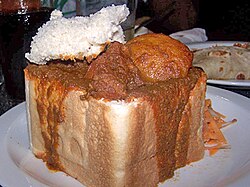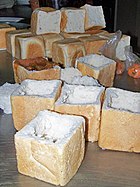Bunny chow
 A "quarter mutton" bunny with topping | |
| Alternative names | Bunny Scambane Kota |
|---|---|
| Type | Curry, sandwich, bread bowl |
| Course | Lunch, dinner, snack |
| Place of origin | South Africa |
| Region or state | Durban |
| Created by | South African Indians |
| Serving temperature | Hot |
| Main ingredients | Bread, curry |
Bunny chow, often referred to simply as a bunny,[1] is a South African fast food dish consisting of a hollowed-out loaf of white bread filled with curry. It ultimately originated among Indian South Africans of Durban.[2] A small version of the bunny chow that uses only a quarter loaf of bread is sometimes called, by black South Africans, a scambane or kota ("quarter"); it is a name that it shares with spatlo, a South African dish that evolved from the bunny chow.[3]
The meal is still called "Bunny chow" or "bunnychow"[needs Afrikaans IPA] in Afrikaans, being a loanword from English.
History
The bunny chow was created in Durban, home to a large community of people of Indian origin. The precise origins of the food are disputed, although its creation has been dated to the 1940s. It was also sold in Gwelo, Rhodesia (now Gweru) during World War II and is still sold in the nearby town of Kadoma, formerly known as Gatooma.
Stories of the origin of bunny chow date as far back as the migrant Indian workers' arrival in South Africa. One account suggests that said Indian laborers who came to work the sugar cane plantations of Kwazulu-Natal (Port Natal) required a way of carrying their lunches to the field; a hollowed-out loaf of bread was a convenient way to transport their vegetarian curries.[4] Meat-based fillings came later. The use of a loaf of white bread can also be ascribed to the lack of the traditional roti bread as well as its weak structure; thus the cheap loaf, widely available at local stores, would be an optimal substitute vessel for the curry.
Etymology

One story claims that a South African restaurant run by Banias of the Indian caste first created the dish at a restaurant-café, called Kapitan's, on the corner of Victoria and Albert streets in Durban.[5] Another tale opines that the origin of this handheld dish was due to Indian golf caddies not being allowed to publicly carry sharp cutlery like knives during apartheid.[3] "Template:Wikteng" in South African English is simply slang for "food" as well as the verb "to eat".
The traditional Indian meal was roti and beans, but rotis tended to fall apart as a take-away item. To solve this, they[who?] hollowed the centre portion of a loaf of white bread and filled it with curry, then capped the filling with the portion that was carved out.[6] The vegetarian version of the meal is sometimes known as a "beans bunny".[5] An alternate, albeit unlikely etymology is derived from a mondegreen of "bun" and "achar" (Indian pickles), though the latter are not usually included in the dish (unless as an accoutrement).[5]
Cuisine

Bunny chows are popular amongst Indians and other ethnic groups in the Durban area. Bunny chows are commonly filled with curries made using traditional recipes from Durban: mutton or lamb, chicken, trotters & beans, bean and chips and with curry gravy are popular fillings now, although the original bunny chow was vegetarian. Bunny chows are often served with a side portion of grated carrot, chilli and onion salad, commonly known as sambals. A key desirable characteristic of a bunny chow is seen when gravy from the curry fillings soaks into the walls of the bread. Sharing a single bunny chow is not uncommon.
Bunny chows come in quarter, half and full loaves. When ordering a bunny chow in Durban, the local slang dictates that you need only ask for a "quarter mutton" (or flavour and size of your choice). Bunny chows are mainly eaten using the fingers; it is unusual to see locals use utensils when eating this dish. Bunny chow used to be presented to customers wrapped in the previous day's newspapers. These days[when?], most bunny chows are packed for takeaways in convenient bunny boxes which help keep the bunny's warm and prevents leaks from the curry.
These days[when?] bunny chows are available in many small takeaways and Indian restaurants throughout South Africa. The price ranges from R 15 (US$1.01) for a quarter beans or dhal, to R 50 (US$3.38) for a quarter mutton bunny, and generally one can multiply the price of a quarter by between 3 and 4 to attain the price of a full bunny.
Each year, the "Bunny Chow Barometer" is held in September on the south bank of the Umgeni River, just above Blue Lagoon (a popular Sunday picnic spot for Durban Indians), attracting numerous entrants from across the Durban Metro region to compete for the title of top bunny maker.[citation needed]
See also
- Bunny Chow, a comedy film
- Gatsby (sandwich) – a South African sandwich
- Spatlo – a similar dish
- List of African dishes
- South African cuisine
- Curry bread, found in Japanese cuisine
References
- ^ Jackson, Allan (2003). "More on the Bunny Chow". Facts About Durban (South Africa). Retrieved 22 August 2011.
- ^ Jaffrey, Madhur (2003). From Curries to Kebabs: Recipes from the Indian Spice Trail. p. 184. Retrieved 28 September 2015.
- ^ a b Kraig, Bruce; Taylor Sen, Colleen (9 September 2013). Street Food Around the World: An Encyclopedia of Food and Culture. ABC-CLIO. pp. 306–307. ISBN 978-1-59884-955-4.
- ^ Warwicker, Michelle (20 January 2014). "What is bunny chow?". BBC Food. Retrieved 28 September 2015.
- ^ a b c Hajratwala, Minal (2009). Leaving India. Westland. pp. 70–71. ISBN 978-93-80032-90-0. Retrieved 28 September 2015.
- ^ "Legends". Quarterbunny. Archived from the original on 13 January 2013. Retrieved 28 September 2015.

